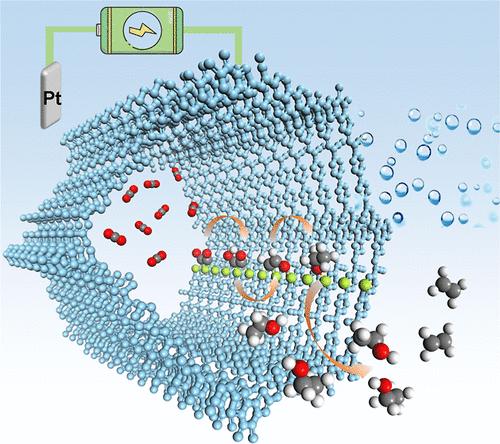在联吡啶基二维共轭共价有机框架上构建互层单原子活性位点,促进电化学二氧化碳还原反应的 C2 产物生成
IF 8.2
2区 材料科学
Q1 MATERIALS SCIENCE, MULTIDISCIPLINARY
引用次数: 0
摘要
电化学二氧化碳还原(eCO2RR)在实现碳中和方面显示出巨大潜力,这需要设计专用催化剂。为了开发有利于 C2 产物的电催化剂,本文利用层间 π-π 堆积,开发了在双吡啶连接的二维共价有机框架(2D c-COF)上设计层间单原子金属活性位点的合成方案。由此产生的 M@BTT-BPy-COF(其中 M = 铜、镍和铁)提供了完全暴露的单原子活性位点,其合适的间距可催化 eCO2RR 过程中的关键 C-C 偶联。M@BTT-BPy-COF 在 -0.8 V 对 RHE 时的乙醇法拉第效率(FEethanol)超过 40%,优于大多数已报道的基于 COF 的电催化剂。密度泛函计算表明,COF 孔道中的近端活性位点是促进 C-C 偶联生成乙醇产物的关键活性位点。这项研究提出了一种在二维 c-COFs 上设计单原子催化中心的新方法,显示了二维 c-COFs 在电催化方面的巨大潜力。本文章由计算机程序翻译,如有差异,请以英文原文为准。

Construction of Interlayered Single-Atom Active Sites on Bipyridine-Based 2D Conjugated Covalent-Organic Frameworks for Boosting the C2 Products of Electrochemical CO2 Reduction
The electrochemical carbon dioxide reduction (eCO2RR) shows great potential in the realization of carbon neutrality, which requires a dedicated catalyst design. To develop electrocatalysts that favor C2 products, herein, the synthetic protocol for engineering interlayered single-atom metal active sites on the bipyridine-linked 2D conjugated covalent-organic framework (2D c-COF) has been developed by utilizing the interlayer π–π stacking. The resultant M@BTT-BPy-COF (where M = Cu, Ni, and Fe) provides fully exposed single-atom active sites with a suitable interdistance for catalyzing the key C–C coupling in the eCO2RR process. The Faradaic efficiency of ethanol (FEethanol) exceeds 40% with M@BTT-BPy-COF at −0.8 V vs RHE, outperforming most reported COF-based electrocatalysts. Density functional calculations suggest that the proximal active sites in the pore channel of COFs are the key active sites for promoting the C–C coupling to generate ethanol product. This investigation presents a novel way to engineer single-atom catalytic centers on 2D c-COFs, displaying the great potential of 2D c-COFs in electrocatalysis.
求助全文
通过发布文献求助,成功后即可免费获取论文全文。
去求助
来源期刊

ACS Applied Materials & Interfaces
工程技术-材料科学:综合
CiteScore
16.00
自引率
6.30%
发文量
4978
审稿时长
1.8 months
期刊介绍:
ACS Applied Materials & Interfaces is a leading interdisciplinary journal that brings together chemists, engineers, physicists, and biologists to explore the development and utilization of newly-discovered materials and interfacial processes for specific applications. Our journal has experienced remarkable growth since its establishment in 2009, both in terms of the number of articles published and the impact of the research showcased. We are proud to foster a truly global community, with the majority of published articles originating from outside the United States, reflecting the rapid growth of applied research worldwide.
 求助内容:
求助内容: 应助结果提醒方式:
应助结果提醒方式:


